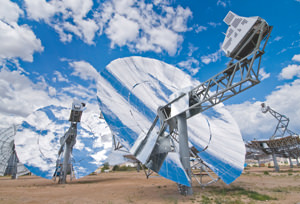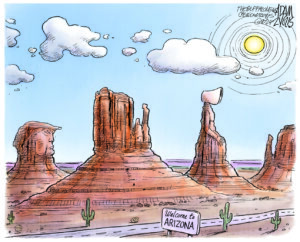Making Solar Power While the Sun Shines
New solar power installations are surging, but a tax rebate that has helped propel them will decrease in 2016. That raises a related question: Why isn't solar power required in all new building construction?
One of the many oddities of American public policy is that solar power installations aren’t required on new building construction in, at the very least, the Sunbelt states — a move that could go a long way toward making solar power a larger provider of electricity. The good news: There’s an explosion in solar installations underway anyway, propelled by both demand and a soon-to-expire federal tax rebate.
Quartz reports that 1,081 MW of utility-scale solar power — such as those big arrays out in the deserts — have come online this year, and the third quarter recorded a 15 percent jump over last year. But it’s the future that Quartz says bears watching. Projects that would generate nearly 38,000 MW of solar power are expected to come online in the next two years, much of it to take advantage of “a 30% federal tax credit that is set to fall to 10% by the end of 2016.”
Rooftop solar accounts for two-thirds of solar installations in the US. Big Solar, however, still holds its appeal as the economies of scale and higher electricity production from deploying hundreds of thousands of solar panels in the sunshine-soaked desert means utilities can lock in cheaper rates under long-term contracts. Just this week, for instance, solar panel manufacturer and developer First Solar announced it would build a 250 MW photovoltaic farm in California for NextEra Energy Resources.
The quarterly numbers for utility-scale solar also can be a bit misleading. It can take years to build a Big Solar power plant and the megawatts are only counted once it begins to generate electricity. So expect big jumps in 2014 when projects like BrightSource Energy’s 370-megawatt Ivanpah solar thermal power plant come online.
Germany — not known for its abundance of sunny days — has already made massive strides in replacing fossil fuel-fired power with solar, so much so that the country’s utilities have been shutting down generating plants.
One of the hurdles to widespread use of solar power is storage — what to do when the sun goes down and the power generation goes off. Technology is catching up. The New York Times reported recently that an Arizona utility is experimenting with technology that would extend solar power as a source through the dark hours:
In a closely watched new solar project called Solana, the energy is gathered in a three-square-mile patch of desert bulldozed flat near Gila Bend, about 50 miles southwest of Phoenix. A sprawling network of parabolic mirrors focuses the sun’s energy on black-painted pipes, which carry the heat to huge tanks of molten salt. When the sun has set, the plant can draw heat back out of the molten salt to continue making steam and electricity.
The emerging technology is one way that the utility industry is trying to make electricity from the sun available even when it is not shining, overcoming one of the major shortcomings of solar power.
“We’re going to care more and more about that as time goes on,” said Brad Albert the utility’s general manager of resource management, in a telephone interview.
The issue has also caught the attention of regulators. In California, the Public Utilities Commission approved a rule on Thursday that will require the state’s three big investor-owned utilities and other electric industry players to install storage by 2024.
That seems like an excessively long time, given the speed with which burning fossil fuels are affecting the climate. But political pressure and some voter and shareholder initiatives could change that.
—Posted by Scott Martelle.
Dig, Root, GrowThis year, we’re all on shaky ground, and the need for independent journalism has never been greater. A new administration is openly attacking free press — and the stakes couldn’t be higher.
Your support is more than a donation. It helps us dig deeper into hidden truths, root out corruption and misinformation, and grow an informed, resilient community.
Independent journalism like Truthdig doesn't just report the news — it helps cultivate a better future.
Your tax-deductible gift powers fearless reporting and uncompromising analysis. Together, we can protect democracy and expose the stories that must be told.
This spring, stand with our journalists.
Dig. Root. Grow. Cultivate a better future.
Donate today.








You need to be a supporter to comment.
There are currently no responses to this article.
Be the first to respond.